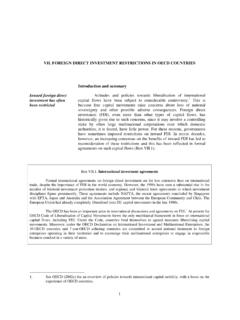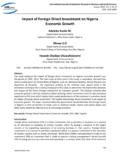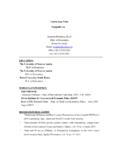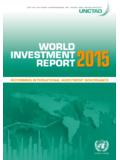Transcription of Foreign direct investment statistics Explanatory notes
1 1 Foreign direct investment statistics Explanatory notes The OECD Benchmark Definition of Foreign direct investment sets the world standard for direct investment statistics . The fourth edition was completed in 2008 and has now been implemented by most reporting countries. This note provides Explanatory information on aspects of FDI statistics , including coverage, measurement, and classification. Definition of FDI direct investment is a category of cross-border investment made by a resident in one economy (the direct investor or parent) with the objective of establishing a lasting interest in an enterprise (the direct investment enterprise or affiliate) that is resident in an economy other than that of the direct investor. The motivation of the direct investor is a strategic long-term relationship with the direct investment enterprise to ensure a significant degree of influence by the direct investor in the management of the direct investment enterprise.
2 The lasting interest is evidenced when the direct investor owns at least 10% of the voting power of the direct investment enterprise. direct investment may also allow the direct investor to gain access to the economy of the direct investment enterprise which it might otherwise be unable to do. The objectives of direct investment are different from those of portfolio investment whereby investors do not generally expect to influence the management of the enterprise. direct investment enterprises are corporations, which may either be subsidiaries, in which over 50% of the voting power is held, or associates, in which between 10% and 50% of the voting power is held, or they may be quasi-corporations, such as branches which are effectively 100% owned by their parents.
3 They may also be fellow enterprises, enterprises that do not have a direct investment relationship themselves but that have a direct investor in common. Transactions between fellow enterprises are included in FDI statistics because they likely result from the influence of the common direct investor. The OECD sets the world standards for compiling FDI statistics through its Benchmark Definition of Foreign direct investment . This document provides information on many aspects of FDI statistics , including: the definition of FDI, the statistical series and variables included in FDI statistics , the relationship between these series, classification principles, the role of Special Purpose Entities in FDI statistics , and related datasets.
4 2 The relationship between the direct investor and its direct investment enterprises may be complex and bear little or no relationship to management structures. direct investment relationships are identified according to the criteria of the Framework for direct investment Relationships (FDIR). FDI statistical series direct investment statistics cover all cross-border transactions and positions between enterprises which are in a Foreign direct investment relationship as defined in the FDIR. FDI statistics include: 1) direct investment positions (stocks) a. equity b. debt (intercompany loans) 2) direct investment income flows a. dividends and distributed branch profits b. reinvested earnings c. income on debt (interest) 3) direct investment financial flows a.
5 Equity b. reinvestment of earnings c. debt Equity includes common and preferred shares (exclusive of non-participating preference shares which should be included under debt), reserves, capital contributions and reinvestment of earnings. Dividends, distributed branch earnings, reinvested earnings and undistributed branch earnings are components of FDI income on equity. Debt instruments include marketable securities such as bonds, debentures, commercial paper, promissory notes , non-participating preference shares and other tradable non-equity securities as well as loans, deposits, trade credit and other accounts payable/receivable. The interest returns on these instruments are included in FDI income on debt. FDI financial transactions may be negative for three reasons.
6 First, if there is disinvestment in assets that is, the direct investor sells its interest in a direct investment enterprise to a third party or back to the direct investment enterprise. Second, if the parent borrowed money from its affiliate or if the affiliate paid off a loan from its direct investor. Third, if reinvested earnings are negative. Reinvested earnings are negative if the affiliate loses money or if the dividends paid out to the direct investor are greater than the income recorded in that period. Negative FDI positions largely result when the loans from the affiliate to its parent exceed the loans and equity capital given by the parent to the affiliate. This is most likely to occur when FDI statistics are presented by partner country. 3 Relationship between FDI Series FDI financial transactions are cross-border transactions between affiliated parties recorded during the reference period (typically year or quarter).
7 FDI positions represent the value of the stock of direct investments held at the end of the reference period (typically year or quarter). The change in direct investment positions from one period to the next is equal to the value of financial transactions recorded during the period plus other changes in prices, exchange rates, and volume. FDI income data are closely linked to the stocks of investments and are used for analysis of the productivity of the investment and calculation of the rate of return on the total funds invested. Measurement principles BMD4 recommends that aggregate FDI statistics , which are included in Balance of Payments and International investment Position accounts, be presented according to the asset/liability principle. On an asset/liability basis, direct investment statistics are organized according to whether the investment relates to an asset or a liability for the country compiling the statistics .
8 For example, a country s assets include equity investments by parent companies resident in that country in their Foreign affiliates because those investments are claims that they have on assets in Foreign countries. Similarly, a country s liabilities include Foreign parents equity investments in affiliates resident in that country because those investments represent claims that foreigners have on assets in the reporting country. It is recommended that aggregate FDI statistics be recorded on the asset/liability basis to make FDI statistics consistent with other macroeconomic statistics . BMD4 recommend that detailed statistics by partner country and by industry be presented according to the directional principle. Under the directional presentation, the direct investment flows and positions are organized according to the direction of the investment for the reporting economy either outward or inward.
9 So, for a particular country, all flows and positions of direct investors resident in that economy are shown under outward investment and all flows and positions for direct investment enterprises resident in that economy are shown under inward investment . The directional principle is most appropriate for studying the nature and motivations of Foreign direct investment . Differences between directional and asset/liability measures of FDI can be quite large in specific countries or in specific time periods. While the same flows are covered by the measures, the different ways they are classified and combined explain the differences. Specifically, the differences between the two measures depend on the size and direction of reverse investment .
10 Reverse investment is when an affiliate invests in its parent. Under the directional presentation, reverse investment is subtracted to derive the amount of total outward or inward investment of the reporting country. So, if a resident parent borrows money from one of its Foreign affiliates, this is subtracted in calculating the reporting country s outward investment because it reduces the amount of money that that country s parents have invested in their Foreign affiliates. Under the asset/liability presentation, it is recorded as a liability of the reporting country. Market value is the preferred conceptual basis to measure both direct investment positions and transactions (flows). 4 Classification principles By economic activity The recommendation is to provide inward and outward FDI data on the basis of the economic activity of both the affiliate and that of the parent.
















